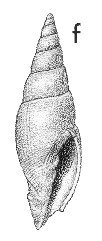
Revised descriptions of New Zealand Cenozoic Mollusca from Beu and Maxwell (1990)

 | Revised descriptions of New Zealand Cenozoic Mollusca from Beu and Maxwell (1990) | 
|
  (Pl. 25f): GS9872, N2/f7611, Te Pokere, north shore Parengarenga Harbour, Northland, Altonian (GNS) |
Beu & Maxwell (1990): Chapter 11; p. 231; pl. 25 f.
Synonymy: Cymbiola nitens Marshall 1918, p. 266; C. masefieldi Marshall 1918, p. 266; Diplomitra nitens; D. masefieldi; Mitra (Eumitra) nitens; M. (Eumitra) masefieldi
Type species of Diplomitra Finlay, 1926, which was synonymised with Eumitra Tate, 1889 by Cernohorsky (1970a)
Classification: Mitridae: Mitrinae
Description: Rather small for family (height 15-30 mm), narrowly fusiform, spire half total height. Protoconch narrowly conical, of about 4 smooth whorls. Teleoconch of 6-7 whorls, spire whorls lightly convex; last whorl broadly excavated, contracted gradually. Spiral sculpture highly variable, some shells with weak cords on base and neck and a few feeble grooves or striae on spire whorls, others with prominent cords on base and neck and well marked cords or grooves above. No axial sculpture apart from growth lines. Aperture narrow, siphonal canal only weakly differentiated, weakly notched; columella almost straight, bearing 2 well developed plaits — the posterior one the stronger — and a much weaker one (obsolete on some shells) below. Inner lip moderately callused; outer lip thin, almost straight, smooth within.
Comparison: Eumitra nitens is distinguished from other New Zealand mitriform gastropods by its slender shape, the restriction of spiral sculpture to the base and neck of most specimens (but present on the rest of the shell on others), and in having only two prominent columellar plaits (and a third much weaker one on some shells). Cernohorsky (1976b, p. 392) suggested that Cymbiola calcar (Otaian or Altonian, Pakaurangi) and Diplomitra waitemataensis (Otaian, Waiheke Island) are additional synonyms of E. nitens. The holotype of Cymbiola calcar is a juvenile shell that is much broader than comparable-sized specimens of E. nitens, has much fewer but coarser basal spiral cords, and has axial costellae similar in strength to the spiral cords on the first few teleoconch whorls; it seems to be a juvenile specimen of Clifdenia turneri, and so an earlier name for C. turneri inflata. The holotype of D. waitemataensis is considerably broader than typical E. nitens and has only one weak columellar plait, but these differences may be related to its greater size (height 41 mm), so it could indeed be conspecific.
Distribution: Waitakian-Altonian; Pakaurangi Formation, Pakaurangi Point, Kaipara Harbour, Otaian-Altonian (type locality of C. nitens and C. masefieldi) (uncommon); Te Pokere, north shore, Parengarenga Harbour (moderately common); upper Tengawai River, South Canterbury (uncommon).
Cite this publication as: "A.G. Beu and J.I. Raine (2009). Revised
descriptions of New Zealand Cenozoic Mollusca from Beu and Maxwell (1990). GNS
Science miscellaneous series no. 27."
© GNS Science, 2009
ISBN
978-0-478-19705-1
ISSN 1177-2441
(Included with a PDF facsimile file
copy of New Zealand Geological Survey Paleontological Bulletin 58 in CD version
from: Publications Officer, GNS Science, P.O. Box 30368 Lower Hutt, New
Zealand)